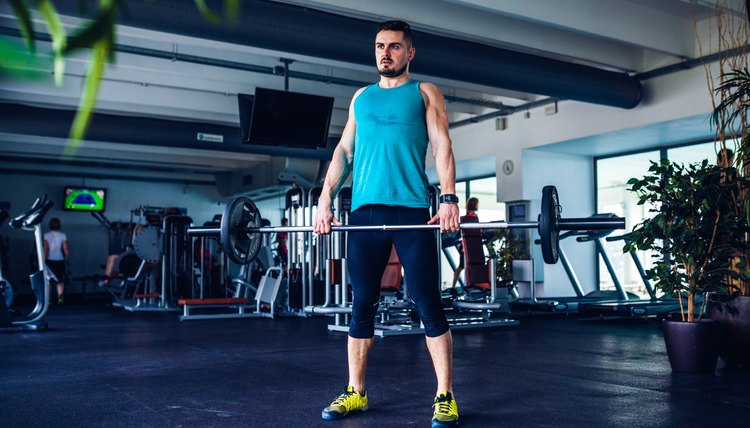Deadlift Vs. Bent-Over Barbell Rows

Deadlifts and bent-over barbell rows are weightlifting exercises that target different muscles in your body; though they may look similar to the untrained eye, they are performed from different positions. Both target strength training for your back, but each exercise focuses on a developing a different area of the back. Consult your doctor before beginning any new exercise routine.
Deadlifts
Deadlifts target your hamstrings, gluteus maximus, erector spinae and adductor magnus muscles, according to the ExRx website. The hamstring is a four-headed muscle located on the back of your thigh; the erector spinae is a three-headed muscle in your back that runs the length of your spine; the gluteus maximus is the muscle that forms your butt; the adductor magnus is a small muscle on your inner thigh.
Bent-Over Barbell Rows
Where deadlifts mostly target the muscles in your lower body and lower back, bent-over barbell rows target several muscles in your upper back. These include the trapezius, rhomboids, latissimus dorsi, teres major and minor, posterior deltoid and infraspinatus, ExRx reports. It also targets two muscles in your arm, the brachialis and brachioradialis of the biceps, and the pectoralis major in your chest.
How to Do Deadlifts
Deadlifts are generally done using a barbell, though you can also use dumbbells or a weighted bar. Grasp a barbell with your hands shoulder-width apart with an overhand grip. Stand tall, holding the barbell against your body; do not lock your knees. With arms straight, start lowering the barbell toward the floor by bending from your waist and hips. Do not squat or bend your knees. Keep your back and arms straight throughout the move. Lower the barbell beyond your knees, then raise back up. Repeat 10 to 20 times and do three sets.
How to Do Bent-Over Barbell Rows
Stand in front of a barbell. Grasp it with an overhand grip, placing your hands shoulder width apart or wider. Bend your knees slightly and bent forward slightly at the waist, holding your back straight. Pull the barbell to your waist by bending your elbows. Bring your elbows up and backward and do not let them splay out to the sides. Lower the barbell close to floor and repeat. Do 10 to 20 repetitions, three sets total.
References
- "Anatomy and Physiology”; Gary Thibodeau, et al.; 2007
- ExRx: Barbell Straight Leg Deadlift
- ExRx: Barbell Bent-Over Row
- Franchi MV, Reeves ND, Narici MV. Skeletal muscle remodeling in response to eccentric vs. concentric loading: Morphological, molecular, and metabolic adaptations. Front Physiol. 2017;8:447. Published 2017 Jul 4. doi:10.3389/fphys.2017.00447
- Negrete RJ, Hanney WJ, Pabian P, Kolber MJ. Upper body push and pull strength ratio in recreationally active adults. Int J Sports Phys Ther. 2013;8(2):138-44.
- Bruno P. The use of "stabilization exercises" to affect neuromuscular control in the lumbopelvic region: a narrative review. J Can Chiropr Assoc. 2014;58(2):119-130.
Writer Bio
Maria Parepalo began writing professionally in 2006 and has published in medical journals as well as online. She graduated with a bachelor’s degree in laboratory sciences from Helsinki Polytechnic in 2002 and is currently working on her doctoral degree in cell and molecular biology.
